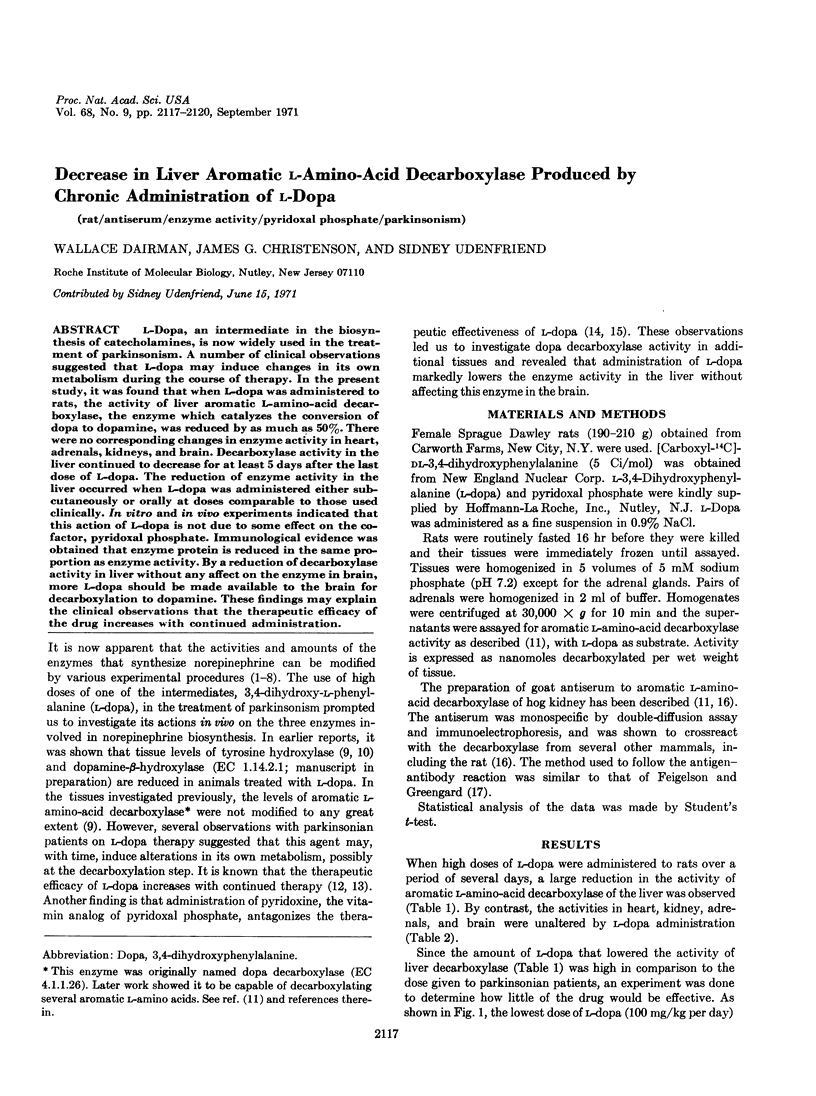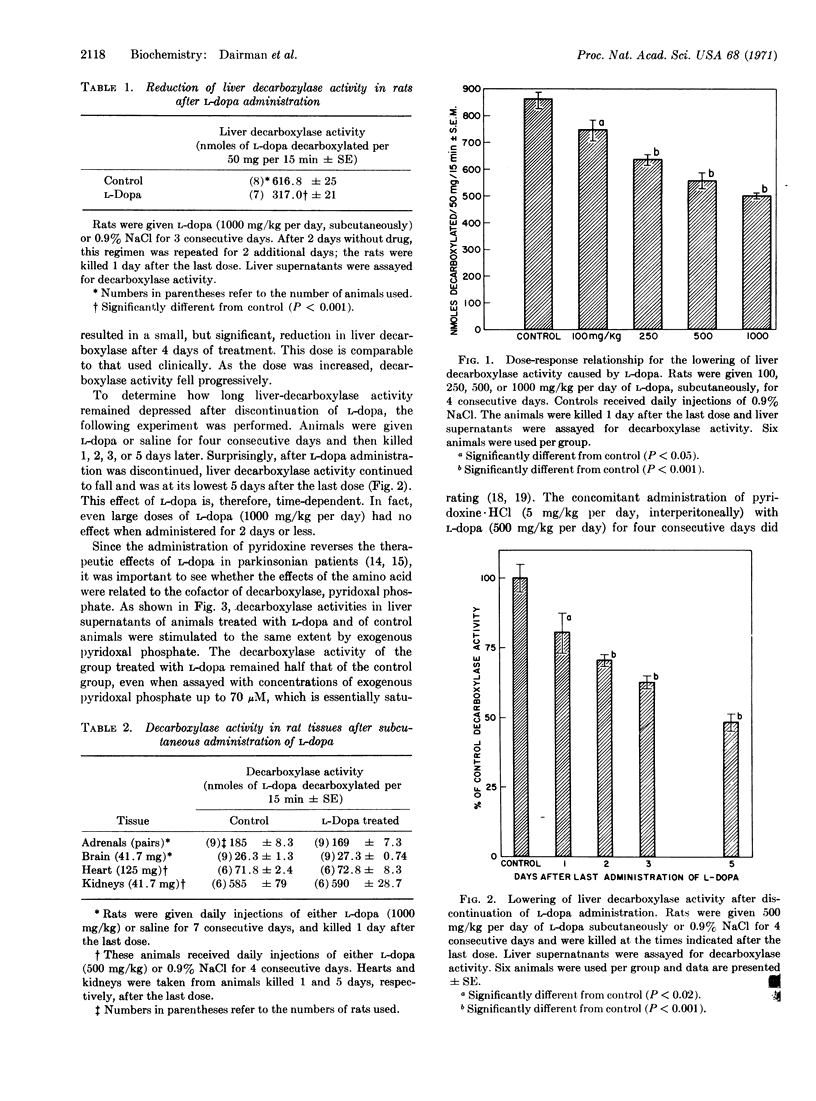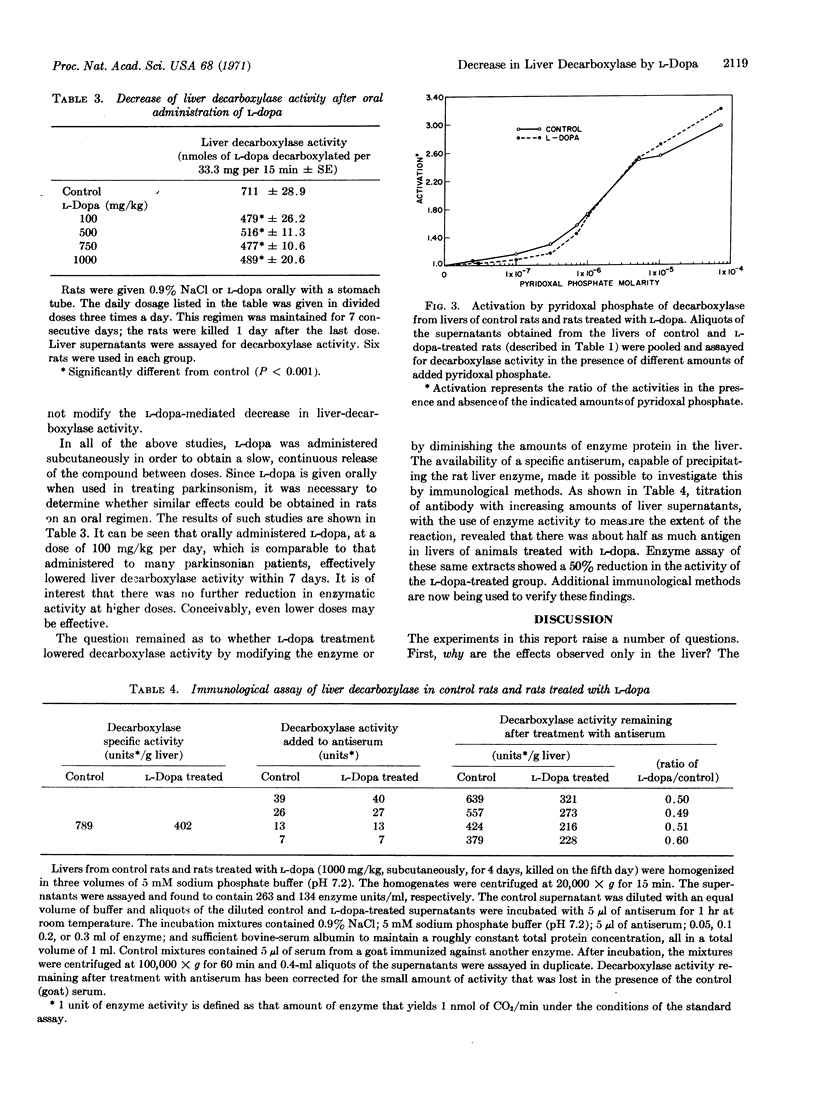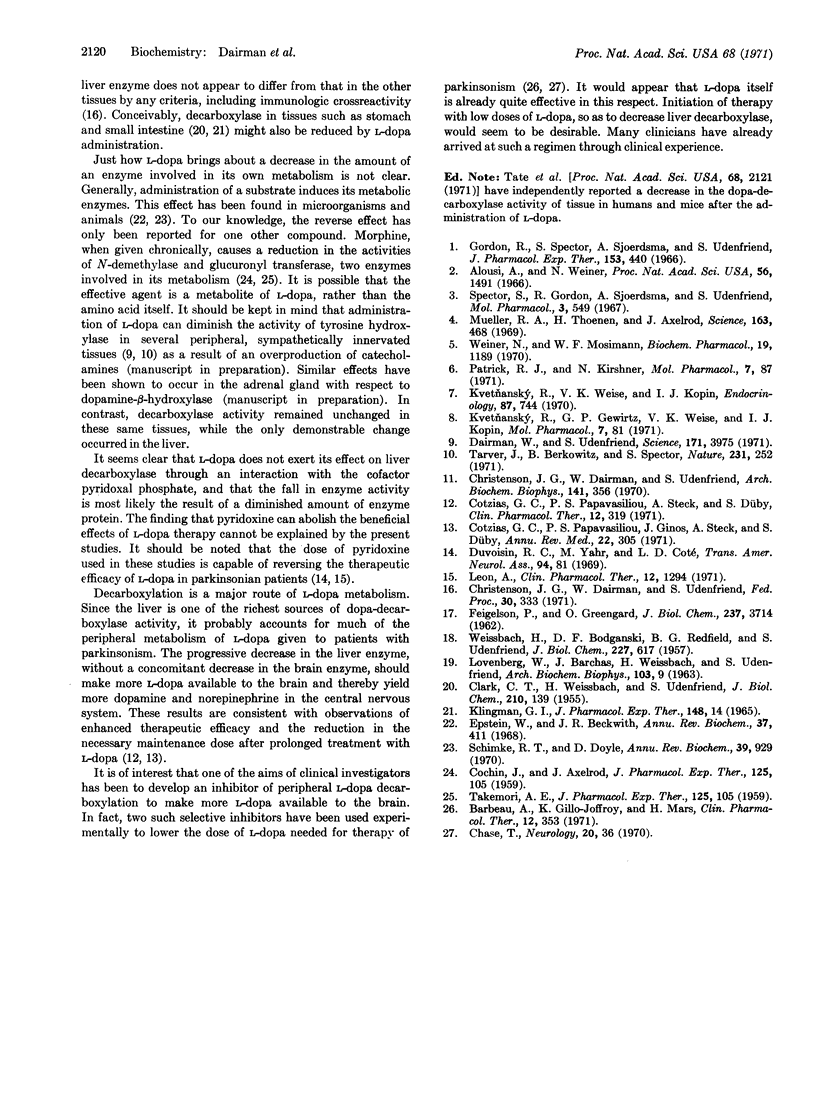Abstract
L-Dopa, an intermediate in the biosynthesis of catecholamines, is now widely used in the treatment of parkinsonism. A number of clinical observations suggested that L-dopa may induce changes in its own metabolism during the course of therapy. In the present study, it was found that when L-dopa was administered to rats, the activity of liver aromatic L-amino-acid decarboxylase, the enzyme which catalyzes the conversion of dopa to dopamine, was reduced by as much as 50%. There were no corresponding changes in enzyme activity in heart, adrenals, kidneys, and brain. Decarboxylase activity in the liver continued to decrease for at least 5 days after the last dose of L-dopa. The reduction of enzyme activity in the liver occurred when L-dopa was administered either subcutaneously or orally at doses comparable to those used clinically. In vitro and in vivo experiments indicated that this action of L-dopa is not due to some effect on the cofactor, pyridoxal phosphate. Immunological evidence was obtained that enzyme protein is reduced in the same proportion as enzyme activity. By a reduction of decarboxylase activity in liver without any affect on the enzyme in brain, more L-dopa should be made available to the brain for decarboxylation to dopamine. These findings may explain the clinical observations that the therapeutic efficacy of the drug increases with continued administration.
Keywords: rat, antiserum, enzyme activity, pyridoxal phosphate, parkinsonism
Full text
PDF



Selected References
These references are in PubMed. This may not be the complete list of references from this article.
- Alousi A., Weiner N. The regulation of norepinephrine synthesis in sympathetic nerves: effect of nerve stimulation, cocaine, and catecholamine-releasing agents. Proc Natl Acad Sci U S A. 1966 Nov;56(5):1491–1496. doi: 10.1073/pnas.56.5.1491. [DOI] [PMC free article] [PubMed] [Google Scholar]
- Barbeau A., Gillo-Joffroy L., Mars H. Treatment of Parkinson's disease with levodopa and Ro 4-4602. Clin Pharmacol Ther. 1971 Mar-Apr;12(2):353–359. doi: 10.1002/cpt1971122part2353. [DOI] [PubMed] [Google Scholar]
- CLARK C. T., WEISSBACH H., UDENFRIEND S. 5-Hydroxytryptophan decarboxylase: preparation and properties. J Biol Chem. 1954 Sep;210(1):139–148. [PubMed] [Google Scholar]
- COCHIN J., AXELROD J. Biochemical and pharmacological changes in the rat following chronic administration of morphine nalorphine and normorphine. J Pharmacol Exp Ther. 1959 Feb;125(2):105–110. [PubMed] [Google Scholar]
- COCHIN J., AXELROD J. Biochemical and pharmacological changes in the rat following chronic administration of morphine nalorphine and normorphine. J Pharmacol Exp Ther. 1959 Feb;125(2):105–110. [PubMed] [Google Scholar]
- Christenson J. G., Dairman W., Udenfriend S. Preparation and properties of a homogeneous aromatic L-amino acid decarboxylase from hog kidney. Arch Biochem Biophys. 1970 Nov;141(1):356–367. doi: 10.1016/0003-9861(70)90144-x. [DOI] [PubMed] [Google Scholar]
- Cotzias G. C., Papavasiliou P. S., Ginos J., Steck A., Düby S. Metabolic modification of Parkinson's disease and of chronic manganese poisoning. Annu Rev Med. 1971;22:305–326. doi: 10.1146/annurev.me.22.020171.001513. [DOI] [PubMed] [Google Scholar]
- Cotzias G. C., Papavasiliou P. S., Steck A., Düby S. Parkinsonism and levodopa. Clin Pharmacol Ther. 1971 Mar-Apr;12(2):319–322. doi: 10.1002/cpt1971122part2319. [DOI] [PubMed] [Google Scholar]
- Gordon R., Spector S., Sjoerdsma A., Udenfriend S. Increased synthesis of norepinephrine and epinephrine in the intact rat during exercise and exposure to cold. J Pharmacol Exp Ther. 1966 Sep;153(3):440–447. [PubMed] [Google Scholar]
- KLINGMAN G. I. CATECHOLAMINE LEVELS AND DOPA-DECARBOXYLASE ACTIVITY IN PERIPHERAL ORGANS AND ADRENERGIC TISSUES IN THE RAT AFTER IMMUNOSYMPATHECTOMY. J Pharmacol Exp Ther. 1965 Apr;148:14–21. [PubMed] [Google Scholar]
- Kvetnansky R., Weise V. K., Kopin I. J. Elevation of adrenal tyrosine hydroxylase and phenylethanolamine-N-methyl transferase by repeated immobilization of rats. Endocrinology. 1970 Oct;87(4):744–749. doi: 10.1210/endo-87-4-744. [DOI] [PubMed] [Google Scholar]
- Kvetnanský R., Gewirtz G. P., Weise V. K., Kopin I. J. Enhanced synthesis of adrenal dopamine beta-hydroxylase induced by repeated immobilization in rats. Mol Pharmacol. 1971 Jan;7(1):81–86. [PubMed] [Google Scholar]
- LOVENBERG W., BARCHAS J., WEISSBACH H., UDENFRIEND S. CHARACTERISTICS OF THE INHIBITION OF AROMATIC L-AMINO ACID DECARBOXYLASE BY ALPHA-METHYLAMINO ACIDS. Arch Biochem Biophys. 1963 Oct;103:9–14. doi: 10.1016/0003-9861(63)90003-1. [DOI] [PubMed] [Google Scholar]
- Mueller R. A., Thoenen H., Axelrod J. Adrenal tyrosine hydroxylase: compensatory increase in activity after chemical sympathectomy. Science. 1969 Jan 31;163(3866):468–469. doi: 10.1126/science.163.3866.468. [DOI] [PubMed] [Google Scholar]
- Patrick R. L., Kirshner N. Effect of stimulation on the levels of tyrosine hydroxylase, dopamine beta-hydroxylase, and catecholamines in intact and denervated rat adrenal glands. Mol Pharmacol. 1971 Jan;7(1):87–96. [PubMed] [Google Scholar]
- Schimke R. T., Doyle D. Control of enzyme levels in animal tissues. Annu Rev Biochem. 1970;39:929–976. doi: 10.1146/annurev.bi.39.070170.004433. [DOI] [PubMed] [Google Scholar]
- Spector S., Gordon R., Sjoerdsma A., Udenfriend S. End-product inhibition of tyrosine hydroxylase as a possible mechanism for regulation of norepinephrine synthesis. Mol Pharmacol. 1967 Nov;3(6):549–555. [PubMed] [Google Scholar]
- Tarver J., Berkowitz B., Spector S. Alterations in tyrosine hydroxylase and monoamine oxidase activity in blood vessels. Nat New Biol. 1971 Jun 23;231(25):252–253. doi: 10.1038/newbio231252a0. [DOI] [PubMed] [Google Scholar]
- Tate S. S., Sweet R., McDowell F. H., Meister A. Decrease of the 3,4-dihydroxyphenylalanine (DOPA) decarboxylase activities in human erythrocytes and mouse tissues after administration of DOPA. Proc Natl Acad Sci U S A. 1971 Sep;68(9):2121–2123. doi: 10.1073/pnas.68.9.2121. [DOI] [PMC free article] [PubMed] [Google Scholar]
- WEISSBACH H., BOGDANSKI D. F., REDFIELD B. G., UDENFRIEND S. Studies on the effect of vitamin B6 on 5-hydroxytryptamine (serotonin) formation. J Biol Chem. 1957 Aug;227(2):617–624. [PubMed] [Google Scholar]


